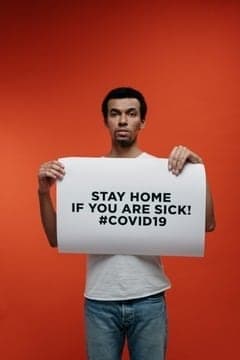Self-quarantine to reduce the risk of infecting others.
Photo credit: Cottonbro
This article was originally published by Jason on Tibu.

All information provided is grounded in World Health Organization (WHO) approved research, literature and best practices. We equally align with the guidelines of Kenyan Ministry of Health.
Under any of the following circumstances, always START by calling the local health authorities (Number in Kenya: 0732353535 / 0729471414). This means before hopping in your local matatu and heading to any health facility (also, don’t just head to any facility please. That would be reckless. Go to Kenyatta National Hospital Infectious Disease Unit). Calling provides health authorities with valuable information that informs preparedness, surveillance and response activities.
Let’s say you begin developing MILD SYMPTOMS (fever, cough, sore throat, general malaise, muscle pain, nasal congestion or headache) that may align with COVID-19 symptoms or you have been exposed to someone with those symptoms and you want or are told to quarantine for 14 days. What do you do? First, call the authorities (I promise, I will never stop telling you to do this). You should then self-quarantine to reduce the risk of infecting others. How do you self-quarantine, you might ask? Read on, my curious public health guru:
1. First, find a well-ventilated room and put yourself in there. We highly recommend cracking a window.
2. Limit your movement around the house, especially in common spaces (applicable to those that do not live alone, of course!).
3. If you are sharing a bed with someone, stop doing so. You should probably have your own room if possible. If this is not possible, try to stay at least 1-meter apart from people. Sorry love birds, cuddling will have to wait.
4. Only one-person should be helping you with your care. Having multiple people care for you increases the risks. Also, try to limit the number of people visiting the home when you are under self-quarantine. Thank God for SMS and WhatsApp!
5. Ensure the person caring for you is either washing their hands or hand-sanitizing after interacting with you or your immediate environment. There’s really no such thing as washing your hands too often in this context. WASH, WASH, WASH!

6. Many of us use towels at home when drying our hands after a good hand wash. STOP doing this and START using disposable paper towels if you are caring for someone with suspected COVID-19. Mother nature will forgive you.
7. The person caring for you should wear a tightly fitted face mask when they are in the same room as you. Make sure they do not touch the front of the mask while it’s being used. Why you might ask? If the front of the mask is contaminated and you touch it with your hands, your hands become contaminated. If you then touch your face or a surface, you have contaminated yourself and those surfaces. Either way, not good. Once you are done using the mask, make sure you remove it safely and discard it in a closed bin. This means not touching the front of the mask but rather untying or removing it using the strap (s) and discarding it immediately. After you’ve removed the mask, go wash your hands.
Face mask notes:
- If you are the sick person you should also consider wearing a mask to help reduce the spread in your environment. You will be coughing, sneezing and sweating and we do not want those infected droplets all over the place. This is particularly important if you do not live alone.
- If you can’t stand using a mask, please make sure you have good hand hygiene and try to not sneeze or cough all over everything. That’s gross and helps spread the disease! Cough or sneeze in your elbow. You’ll also want to make sure surfaces are disinfected regularly (point 11 below).
8. The person caring for you should also wear disposable gloves while caring for you. These should be discarded immediately after use. Don’t wash or try to reuse these things. Just toss them in a closed bin. Always wash your hands after removing the gloves and discarding them.
9. Best practice has it that dedicated linens and utensils should be used for the person who is ill. You can wash these normally with soap and water and can re-used them after doing so. How do you go about washing linens that are contaminated? First, it’s best to collect these with gloves and a plastic apron on to avoid contact. Put these linens in a bag to keep them separate from other linens. Try to avoid contact with contaminated linens. If you are washing things by hand, we would suggest wearing gloves, a plastic apron and even a face mask while doing so in case of splashes. Then proceed to washing them normally with laundry soap and make sure they are well dried before using them again.
10. This is a big one: clean surfaces regularly with detergent and disinfectant! This includes all surfaces in the patient's room. For example, bedside tables, bed frames, door handles, bathroom toilets, other furniture etc. Do this with gloves on and DO NOT touch your face while cleaning. This includes your mobile phones, laptops, tablets, computers, gadgets, etc! Think about how often you put that mobile up against your face!
11. If you need to go out for supplies or medications and do not have someone who can do this for you, please wear a mask and limit your contact with people. It would be much better to have friends or family deliver essentials if possible!
NOTE:
If you are caring for someone with suspected covid-19 or have been exposed to someone with suspected covid-19, you are going to have to actively monitor your health for 14 days and be extra careful. Sorry!
We hope this is helpful and helps put your mind at ease.
This article was originally published by Jason on Tibu.
"Find this information helpful? Spread awareness by sharing with your community. We are all in this together!"

